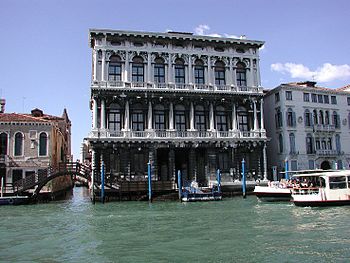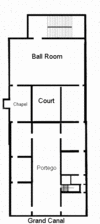- Ca' Rezzonico
-
Ca' Rezzonico is a palazzo on the Grand Canal in Venice. Today it is a public museum dedicated to 18th century Venice.
Contents
Design
Ca' Rezzonico stands on the right bank of the canal, at the point where it is joined by the Rio di San Barnaba. The site was previously occupied by two houses belonging to the Bon family, one of Venice's patrician families. In 1649 the head of the family, Filippo Bon decided to build a large palazzo on the site. For this purpose he employed Baldassarre Longhena, the greatest proponent of Venetian Baroque, a style slowly replacing the Renaissance and Palladian architectural style of such palazzi as (its near neighbour) Palazzo Balbi and Palazzo Grimani built over 100 years previously. However, neither architect nor client was to see the completion of the Palazzo Bon: Longhena died in 1682, and Filippo Bon suffered a financial collapse.
The design was for a three story marble façade facing the canal. The ground floor rusticated, containing a central recessed portico of three bays without a pediment, symmetrically flanked by windows in two bays. Above this the piano nobile of seven bays of arched windows, separated by pilasters, above this the "second piano nobile" was near identical, and above this a mezzanine floor of low oval windows. The slight projection of the two tiers of balconies to the piano nobili accentuate the baroque decoration and design of the building. The palazzo today follows this form, although it was not finished until 1756 by the architect Giorgio Massari, who had been brought in to oversee the completion of the project by the new owners - the Rezzonico Family. Massari however, seems to have adhered to the original plans of Longhena, with the addition of some concepts of his own which reflected the change in architecture between the palazzo's conception and its completion 100 years later.
The Rezzonico family
The unfinished palazzo had been bought from the impoverished Bon family by Giambattista Rezzonico. His family, like their friends at the Palazzo Labia, had bought their noble Venetian status in the mid-17th century following a war with Turkey, when the Venetian state coffers were depleted. Hence the mere rich, as opposed to the wealthy aristocracy, could make a large donation to the Serene Republic, thus purchasing patents of nobility and having their names inscribed in the Libro d'Oro (the "Golden Book").
A Canaletto painting of the early 18th century[1] shows only the ground floor and first piano nobile completed, and a temporary roof protecting the structure from the elements. The completion of the palazzo symbolised the completion of the Rezzonico's upward social journey. The pinnacle of the Rezzonico's power and the Palazzo's grandeur came in 1758, when Carlo, son of Giambattista Rezzonico, was elected Pope as Clement XIII, the same year Ludovico Rezzonico married Faustina Savorgnan in Venice. Ludovico later became the procurator of St. Mark's Basilica. By 1810 the family had died out, leaving only their palazzo to preserve the Rezzonico name.
Interior
In 1758 the newly completed palazzo was enhanced further, by the addition of frescos to the ceilings of the state rooms on the piano nobile overlooking the rio di San Barnaba. The artists selected for this task were Jacopo Guarana, Gaspare Diziani and most importantly Giambattista Tiepolo. These frescos remaining today are among the finest preserved in Venice.
The Palazzo's principal rooms are arranged on the 1st piano nobile; on all floors the famous canal facade is only three rooms wide. On each side of the building a suite of four state rooms lead from the grand canal facade to the largest room in the palazzo - the magnificent ballroom at the rear. This room, created by Massari, is of double height. The walls are decorated in trompe l'oeil by the Lombard Pietro Visconti. The images are of an architectural nature, which create the feeling that the large room is even more massive than it is. The ceiling, painted by Giovan Battista Crosato, depicts Apollo riding his carriage between Europe, Asia, Africa and The Americas. The Ballroom and following state rooms are reached by the vast staircase of honour, its marble balustrades decorated with statuary by Giusto Le Court. Le Court the leading sculptor in Venice in the late 17th century worked closely on many projects with the first architect Longhena, which suggests the regal importance the ballroom and staircase give to the palazzo was one of the intentions of the patrician Bon family rather than the 'arriviste' Rezzonicos.
The piano nobile also contains such rooms as the Chapel, and the beautifully frescoed Nuptial Allegory Room decorated to celebrate the 1758 marriage of Ludovico Rezzonico. Ludovico and his bride are depicted by Tiepolo in trompe l'oeil drawn across the ceiling in Apollo's chariot.[2] This romantic theme is continued in the adjoining room, thus celebrating the happy marriage. This room and the Palazzo Labia ballroom house major ceiling frescoes "in situ" by Tiepolo in Venice.
At the centre of the rectangular palazzo is a small courtyard decorated with sculptures and a small fountain; the court is overlooked by the colonnaded balcony of the piano nobile. The ground floor resembles a mere expansion of the vaulted portego - a hall which links the canal entrance to the land entrance at the rear.
Ca' Rezzonico in the 19th century
In the early years of the 19th century the palazzo was to become Jesuit College, however through complicated inheritance it finally came into the hands of the Pindemonte-Giovanelli family. In 1832 the family sold the entire furnishings and collections of the palazzo. Only the frescos remained in situ. In 1837 Ca' Rezzonico was acquired by Count Ladislao Zelinsky, he in turn let the palazzo to a succession of aristocratic tenants. In the 1880s it became the home of the painter Robert Barrett Browning, whose father Robert Browning, the poet, died in his apartment on the mezzanine floor in 1889. At this time the American portrait painter John Singer Sargent also had a studio in the palazzo.
In 1906 Browning ignoring an offer from the German Emperor Wilhelm II sold the building to Count Lionello von Hierschel de Minerbi instead. The extravagant, art loving de Minerbi (who refurnished the palazzo with objets d'art, sometimes in questionable taste) lived lavishly at the palazzo until 1935 when, like his predecessors the Bon family, the money ran out.
Ca' Rezzonico today
In 1935 after lengthy negotiations Ca' Rezzonico was acquired by City Council of Venice to display the vast collections of 18th century Venetian art, which lack of space prevented its display in the Correr Museum.
Thus today the palazzo is more sumptously furnished than ever before. Further paintings by Tiepolo have been added, including an entire frescoed ceiling, depicting 'The Allegory of Merit', which was rescued from Palazzo Barbarigo, now in the throne room.
The Throne Room was originally described as a bridal chambers of the Rezzonico family; today it is of all the reconstructed chambers perhaps the most remarkable, consisting chiefly of articles pertaining to the Venetian patrician family of Barbarigo. One of the most remarkable items in the room after the ceiling, is a picture frame. This ornate gilt frame celebrates with putti, shields and other allegories the glories of the illustrious family of Barbarigo. It was originally given to Pietro Barbarigo whose portrait it surrounds. The room is named for the ornate gilt chair or throne by rococo sculptor Antonio Corradini. Two very similar chairs were included in the sale at Mentmore Towers in the 1970s, rather than serving as the thrones of monarchs, they were often used by high ranking priests in the many churches of the city during the interminable masses.
In addition to the throne room, a Chinese style salon from the palazzo of the Calbo-Crotta family and many more entire rooms have been salvaged from decaying Venetian palazzi.
Numerous paintings by such artists as Pietro Longhi, Francesco Guardi and Giandomenico Tiepolo can be found in the Palazzo. In addition to collections of antique furniture, there is also a fine collection of Venetian glass, showing that the skills of the 18th century masters at Murano were probably superior to those on the island today.
Ca' Rezzonico opened as a public museum in 1936. Today it is one of the finest museums in Venice; this is largely because of its unique character, where objects designed for great palazzi are displayed in a palazzo, thus the contents and the container harmonise in a way not possible in a purpose built museum.
References
External links
Coordinates: 45°26′00″N 12°19′34″E / 45.433470°N 12.326242°E
Accademia | Arsenal | Bridge of Sighs | Ca' d'Oro | Ca' Foscari | Ca' Pesaro | Ca' Rezzonico | Ca' Vendramin Calergi | Canal Grande | Doge's Palace | Il Redentore | Rialto Bridge | San Giorgio Maggiore | St. Mark | Santa Maria della Salute | Santa Maria Gloriosa dei Frari | Santi Giovanni e Paolo
Categories:- Palaces in Venice
- Museums in Venice
- Houses completed in 1758
- Baroque architecture in Venice
Wikimedia Foundation. 2010.


